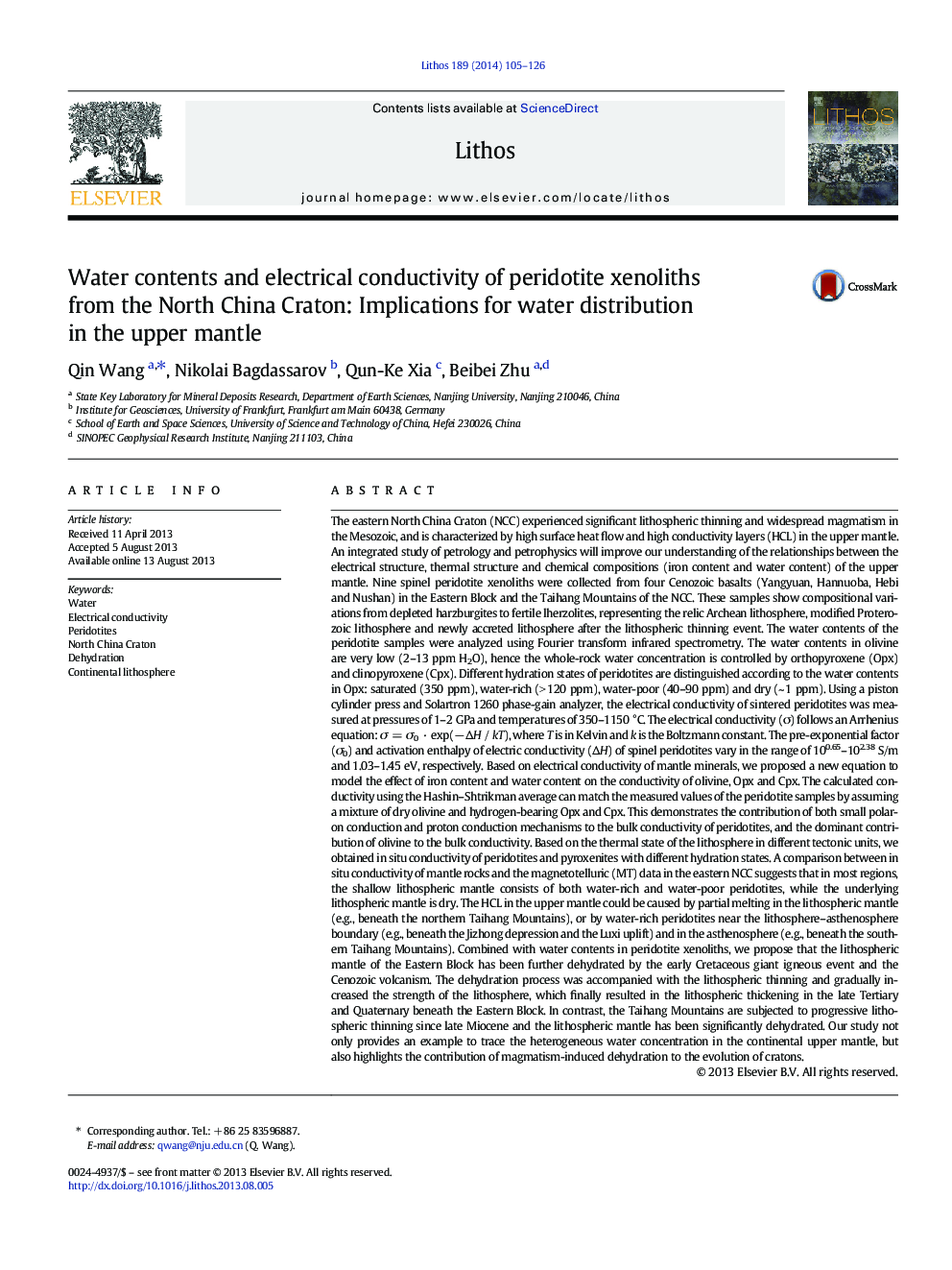| کد مقاله | کد نشریه | سال انتشار | مقاله انگلیسی | نسخه تمام متن |
|---|---|---|---|---|
| 4716107 | 1638681 | 2014 | 22 صفحه PDF | دانلود رایگان |

• The water budget of peridotites is controlled by orthopyroxene and clinopyroxene.
• The conductivity of peridotites is controlled by olivine.
• Effects of iron content and water on the conductivity of peridotites are modeled.
• We distinguished high conductivity layers by partial melting or water-rich peridotites.
• Magmatism in early Cretaceous dehydrated the lithosphere of the North China Craton.
The eastern North China Craton (NCC) experienced significant lithospheric thinning and widespread magmatism in the Mesozoic, and is characterized by high surface heat flow and high conductivity layers (HCL) in the upper mantle. An integrated study of petrology and petrophysics will improve our understanding of the relationships between the electrical structure, thermal structure and chemical compositions (iron content and water content) of the upper mantle. Nine spinel peridotite xenoliths were collected from four Cenozoic basalts (Yangyuan, Hannuoba, Hebi and Nushan) in the Eastern Block and the Taihang Mountains of the NCC. These samples show compositional variations from depleted harzburgites to fertile lherzolites, representing the relic Archean lithosphere, modified Proterozoic lithosphere and newly accreted lithosphere after the lithospheric thinning event. The water contents of the peridotite samples were analyzed using Fourier transform infrared spectrometry. The water contents in olivine are very low (2–13 ppm H2O), hence the whole-rock water concentration is controlled by orthopyroxene (Opx) and clinopyroxene (Cpx). Different hydration states of peridotites are distinguished according to the water contents in Opx: saturated (350 ppm), water-rich (> 120 ppm), water-poor (40–90 ppm) and dry (~ 1 ppm). Using a piston cylinder press and Solartron 1260 phase-gain analyzer, the electrical conductivity of sintered peridotites was measured at pressures of 1–2 GPa and temperatures of 350–1150 °C. The electrical conductivity (σ) follows an Arrhenius equation: σ = σ0 · exp(− ΔH / kT), where T is in Kelvin and k is the Boltzmann constant. The pre-exponential factor (σ0) and activation enthalpy of electric conductivity (ΔH) of spinel peridotites vary in the range of 100.65–102.38 S/m and 1.03–1.45 eV, respectively. Based on electrical conductivity of mantle minerals, we proposed a new equation to model the effect of iron content and water content on the conductivity of olivine, Opx and Cpx. The calculated conductivity using the Hashin–Shtrikman average can match the measured values of the peridotite samples by assuming a mixture of dry olivine and hydrogen-bearing Opx and Cpx. This demonstrates the contribution of both small polaron conduction and proton conduction mechanisms to the bulk conductivity of peridotites, and the dominant contribution of olivine to the bulk conductivity. Based on the thermal state of the lithosphere in different tectonic units, we obtained in situ conductivity of peridotites and pyroxenites with different hydration states. A comparison between in situ conductivity of mantle rocks and the magnetotelluric (MT) data in the eastern NCC suggests that in most regions, the shallow lithospheric mantle consists of both water-rich and water-poor peridotites, while the underlying lithospheric mantle is dry. The HCL in the upper mantle could be caused by partial melting in the lithospheric mantle (e.g., beneath the northern Taihang Mountains), or by water-rich peridotites near the lithosphere–asthenosphere boundary (e.g., beneath the Jizhong depression and the Luxi uplift) and in the asthenosphere (e.g., beneath the southern Taihang Mountains). Combined with water contents in peridotite xenoliths, we propose that the lithospheric mantle of the Eastern Block has been further dehydrated by the early Cretaceous giant igneous event and the Cenozoic volcanism. The dehydration process was accompanied with the lithospheric thinning and gradually increased the strength of the lithosphere, which finally resulted in the lithospheric thickening in the late Tertiary and Quaternary beneath the Eastern Block. In contrast, the Taihang Mountains are subjected to progressive lithospheric thinning since late Miocene and the lithospheric mantle has been significantly dehydrated. Our study not only provides an example to trace the heterogeneous water concentration in the continental upper mantle, but also highlights the contribution of magmatism-induced dehydration to the evolution of cratons.
Journal: Lithos - Volume 189, 15 February 2014, Pages 105–126